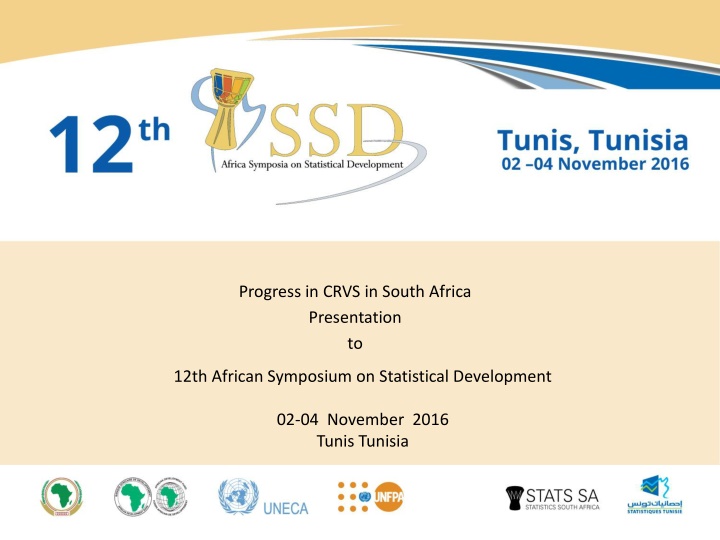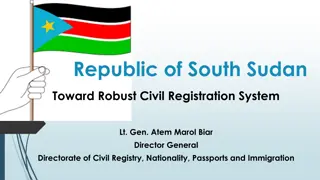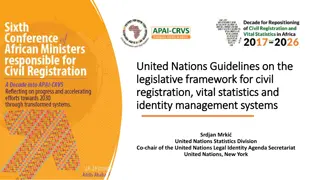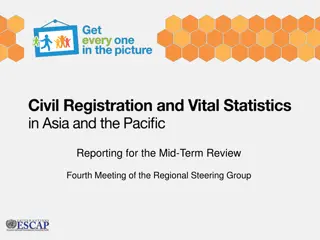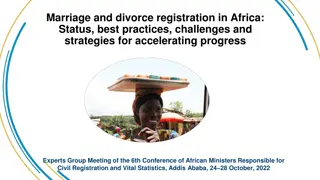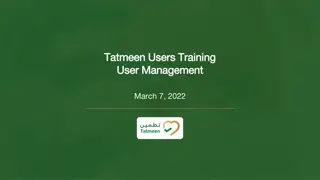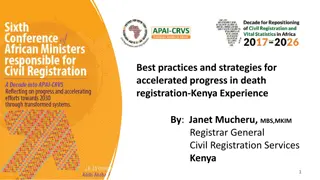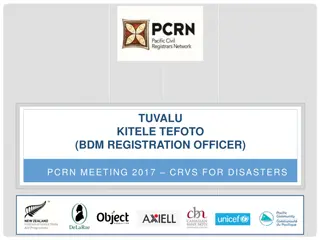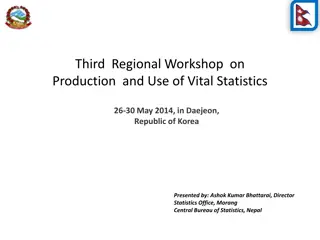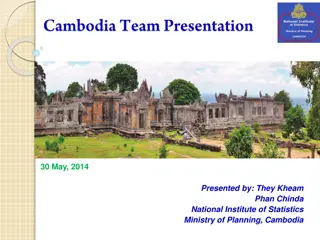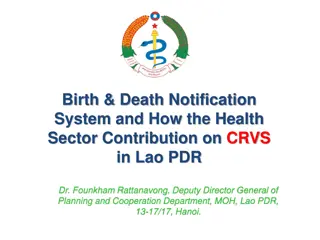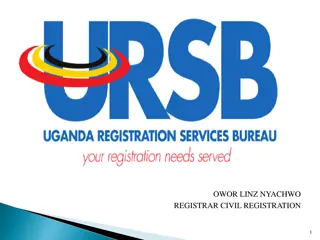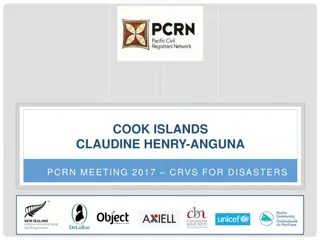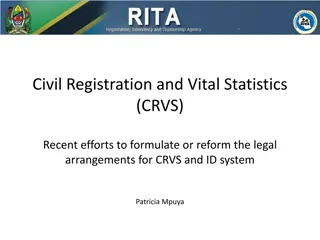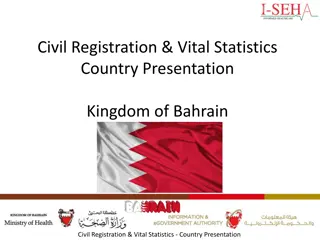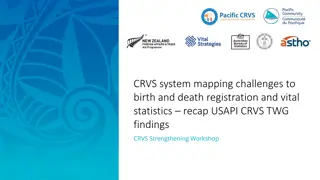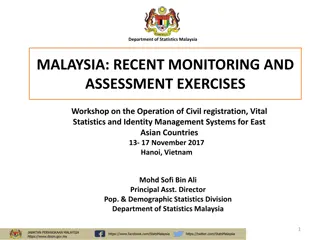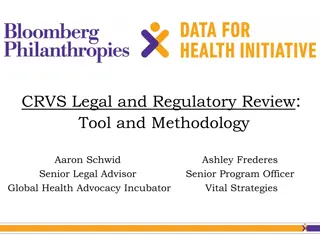Progress in Civil Registration and Vital Statistics System in South Africa
This presentation highlights the progress, challenges, and lessons learned from a comprehensive assessment of South Africa's CRVS system. It delves into the roles of various departments, the goals of the assessment, and the way forward for strengthening the CRVS system in the country. The assessment aimed to identify strengths and weaknesses, establish baselines, and mobilize support for a strategic plan to enhance the overall performance of the CRVS system.
Download Presentation

Please find below an Image/Link to download the presentation.
The content on the website is provided AS IS for your information and personal use only. It may not be sold, licensed, or shared on other websites without obtaining consent from the author.If you encounter any issues during the download, it is possible that the publisher has removed the file from their server.
You are allowed to download the files provided on this website for personal or commercial use, subject to the condition that they are used lawfully. All files are the property of their respective owners.
The content on the website is provided AS IS for your information and personal use only. It may not be sold, licensed, or shared on other websites without obtaining consent from the author.
E N D
Presentation Transcript
Progress in CRVS in South Africa Presentation to 12th African Symposium on Statistical Development 02-04 November 2016 Tunis Tunisia
Outlineofthepresentation CRVS in South Africa Background of the CRVS Assessment Goal of the assessment The scope of the assessment The process Challenges Lesson learned Way forward 2
The South African CRVS System Department Correctional Services (DoJ&CS) of Justice and Department of Home Affairs (DHA) o The custodian of the identity of all South African citizens o Critical to which is the issuance of: o Responsible for: Issuance of divorce decrees birth, marriage and death certificates; Completion of divorce forms used produce statistics on divorces identity documents (IDs) and passports; citizenship; naturalisation and permanent residency certificates 3
TheSouthAfricanCRVSSystem..Cont Department of Health (DoH) o Responsible for ; Statistics South Africa (Stats SA) o Responsible for; Certification of the occurrence of birth and death Production of vital statistics Annual publications of births, deaths (including causes of death), marriages and divorces Certification of causes of death 4
Background South Africa CRVS assessment undertaken in October 2014. Establishment of working groups; oSteering committee. oTechnical Working group (TWG). oTask teams (Lead by TWG). The assessment was lead by six departments involved in CRVS ; oDepartment of Home Affairs o Department of Health o Department of Justice and Correctional Services o Department of Basic Education (DBE); o The Presidency and o Statistics South Africa o Technical support from UN agencies 5
Goal of the assessment : Identify strengths and weaknesses in the current systems and identify interventions for strengthening South Africa s CRVS systems. Obtain information that will enhance overall performance of the CRVS system and influence the direction of development of the systems Establish an objective baseline that forms the basis for follow-up evaluations Build consensus around priority areas for CRVS system strengthening; and mobilise technical and financial support for the implementation of a national strategic plan Present exceptional learning from peers and clients/users from the self- assessment process. Assist the government and partners to distinguish the key issues, and increase the use of CRVS records 6
Theassessmentprocess A qualitative study (Self assessment). Data collection was undertaken with all 9 provinces (two areas each). Desk review: o Literature on current CRVS status o A comprehensive review of the policy and legal environment for CRVS in the country by legal team from three lead departments. Data processing and analysis undertaken by the Technical Working Group (TWG). Report writing by a small sub-group of TWG.
Wayforward: Report taken for external review. Reconstitution of the CRVS teams in preparation for the strategic plan. Communication of results to key stakeholders. Advocacy for better support from national CRVS partners. Mobilise for dedicated resources to complete the process.
Achievements CRVS report finalised Improved communication and coordination between government and NGO with CRVS interest. Creation of a working group to undertake review of the DNF Legislative reform introduced to improve civil registration, e.g. introduction of punitive measures for late registration of births. Private public partnership in deliver of services e.g. application for smart ID through banks. Introduction of electronic data acquisition from Department of Home Affairs Consistent publication of Births, deaths and marriages data based on civil registration data:
9.5 March had the highest proportion of birth occurrences for all the years 9.0 Percentage of births 8.5 8.0 7.5 2014 2013 2012 7.0 November December March October May April July June January August September February Month of birth occurrence
Top ten leading causes of death by sex- 2014 Male Number Female Number Rank % Rank % 22 545 9,5 15 174 7,1 Tuberculosis 1 1 11 202 4,7 10 739 5,0 Influenza and pneumonia 2 6 11 160 4,7 10 685 5,0 Human immunodeficiency virus [HIV] disease 3 7 9 908 4,2 13 149 6,1 Cerebrovascular diseases 4 3 9 872 4,2 11 418 5,3 Other forms of heart disease 5 4 8 914 3,8 13 819 6,4 Diabetes mellitus 6 2 7 300 3,1 . Chronic lower respiratory diseases 7 6 913 2,9 7 019 3,3 Other viral diseases 8 9 6 796 2,9 7 607 3,5 Intestinal infectious diseases 9 8 6 670 2,8 11 081 5,2 Hypertensive diseases 10 5 . 4 913 2,3 Malignant neoplasms of female genital organs 10 Diabetes second leading COD for females and influenza and pneumonia for males 11
Challenges Completion of assessment process delayed Lack of resources to undertake upstream CRVS processes; Review of report (Internal and external) Dedicated personnel to complete the process. Capacity of TWG affected by exit of key role players. Transition from manual processing to electronic system slow. Lack of cooperation from some of the critical stakeholders
Lessons Learned Continued commitment of steering committee ensure sustainability of project Maintaining long term commitment requires dedicated coordination mechanism. Building capacity ensures sustainability of the The level of cooperation between the partner departments in the assessment also contributed to the progress achieved in the assessment project. process. Institutionalising processes ensures sustainability Realistic resources allocation (Human and General interest in the outcome of assessment and the improvement of governmental organisations in SA. financial ) to important for project success. CRVS among non- Inclusion of risk mitigation strategies critical to the success of the project. Quality improvement in is a long term process Creating a dedicated team at the beginning of the project is critical 14
